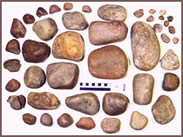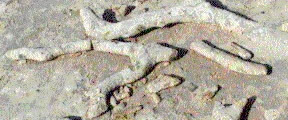
| Fossil

Gastroliths of a plesiosaur. Presumably, they were used for ballast.
Photo: M. Everhart. Used with permission.


To a geology student, the word fossil evokes an image of a petrified dinosaur skeleton, of a fern leaf, or of shells. These are all body fossils, petrifications of the body, usually of its hard parts. With some exceptions, an individual can be preserved as only one body fossil.
Burrow casts belong to the category of trace fossils. All discrete traces of biological activity found in sediment are put in this category: coprolites and gizzard stones, trackways and burrows. A single individual can produce a large number of trace fossils.
Body parts are commonly transported long distances before being buried, and it is rarely possible to identify the exact origin of a fossil. Body fossils can commonly be reworked and then not only the original location, but also the age of the fossil may be unclear. Trace fossils,are found in place (in situ), and so give an exact indication of the animal's age and environment.
Behaviour is difficult to infer from body fossils, and these inferences often involve much speculation. Trace fossils provide a more direct record of behaviour.